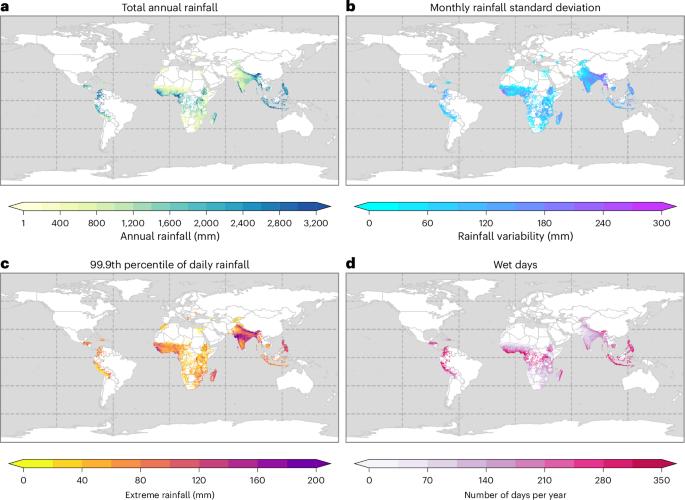Rainfall variability and under-five child mortality in 59 low- and middle-income countries
IF 24.1
引用次数: 0
Abstract
Climate change is reshaping the Earth’s hydrological cycle. Such changes impact children’s health through multiple pathways. Here we show that, in 59 low- and middle-income countries, although sufficient annual rainfall decreases under-five child mortality, anomalies in seasonal rainfall could increase under-five mortality. The risk associated with rainfall scarcity (odds ratio 1.15, 95% confidence interval (CI) 1.11–1.20) was much higher than that associated with rainfall surplus (odds ratio 1.04, 95% CI 1.02–1.06). Extreme rainfall amounts and the number of wet days are positively associated with elevated under-five child mortality. These risks were more pronounced for children from rural areas, families with lower educational attainment and households that depend on natural water sources. From 2000 to 2020, rainfall variations, extreme daily rainfall events and the number of wet days are estimated to cause 290 under-five child deaths per 10,000 persons annually (95% CI 177– 417). This investigation provides important insights into the overlooked health consequences of rainfall pattern changes on vulnerable populations. Climate change is transforming the water cycle and impacting the availability of food and water—effects that are most severe in low- and middle-income countries, where they can impact child mortality substantially. Analyses of rainfall patterns indicate that although increased annual rainfall is associated with improved child survival, these benefits depend on seasonal stability and the absence of extreme weather events.

59个低收入和中等收入国家的降雨变异性和五岁以下儿童死亡率
气候变化正在重塑地球的水文循环。这些变化通过多种途径影响儿童的健康。在这里,我们表明,在59个低收入和中等收入国家,尽管充足的年降雨量降低了五岁以下儿童死亡率,但季节性降雨的异常可能会增加五岁以下儿童死亡率。与降雨缺乏相关的风险(优势比1.15,95%可信区间(CI) 1.11-1.20)远高于与降雨过剩相关的风险(优势比1.04,95% CI 1.02-1.06)。极端降雨量和潮湿天数与五岁以下儿童死亡率升高呈正相关。这些风险在农村地区、受教育程度较低的家庭和依赖天然水源的家庭中更为明显。从2000年到2020年,降雨变化、极端日降雨事件和潮湿天数估计每年导致每10万人中290名五岁以下儿童死亡(95%置信区间177 - 417)。这项调查对降雨模式变化对脆弱人群造成的被忽视的健康后果提供了重要见解。气候变化正在改变水循环,影响粮食和水的供应,这种影响在低收入和中等收入国家最为严重,可能对儿童死亡率产生重大影响。对降雨模式的分析表明,尽管年降雨量增加与儿童存活率的提高有关,但这些好处取决于季节稳定性和极端天气事件的缺失。
本文章由计算机程序翻译,如有差异,请以英文原文为准。
求助全文
约1分钟内获得全文
求助全文

 求助内容:
求助内容: 应助结果提醒方式:
应助结果提醒方式:


